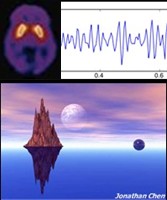
| Energy in Nature | Inventors & Inventions | Workbench Fun | Physics Lab |
|
Consumer Products | Computers | Automation & Robotics | What's in the Future |
|
The
You’ve got a lot of work to do. Current brain scan and EEG equipment
only shows colored regions of activity or squiggly lines on a graph
paper – you want something that will play well on a wide, high-def
screen. So how do you obtain, record, translate, process, and
display your nocturnal experience so that it's worthy of being the
main event of an evening get-together with friends?
Step 1: data collection. This is the most critical to fidelity, but
unfortunately, where the most compromises need to be made as well.
Since this is primarily for entertainment, penetrating the scalp
isn't a consideration. Some sort of sensory "hat" needs to be
designed that's both non-invasive and comfortable enough to wear for
a good night's sleep. It also has to have enough resolution and
sensitivity to your mind's brain waves that a fairly accurate and
detailed media experience can be derived from the collected data.
There's also the reality that brain waves emitted from our head are
only a very small indication of what's going on inside. In addition
to electrical activity, much of the brain's function is chemical -
neurotransmitter molecules passing between the nerve cells. You can
construct your sensory hat with extremely responsive electrodes, and
use a system of triangulation to pinpoint the origin of each
emission, but the chemical part you'll just have to guess at. This
will be like trying to picture what's going on at a party in the
next room by pressing your ear against the wall. It's not an ideal
system, but it's realistically all you have to work with - so step 2
becomes essential. Step 2:
interpretation. This is where computing power tries
to make sense of massive amounts of raw data. Once you've made your
sensory unit and fit it on your head so it won't slide around, you
have to teach the system to interpret what the high-speed and
complex electrical patterns that it detects may represent. The best
way you can think of is to "insert" pre-determined images and
experiences into your consciousness by presenting them on some sort
of virtual-reality media player. You first try to clear your mind of all other
thoughts to minimize mental artifacts, then focus just on what your
device presents to you. By repeating this process with a wide
variety of these experiences and images, and reading the resulting brain-wave patterns each time, you
hope your system is starting to "learn" on at least a crude level
what the patterns represent. Because dreams are ultimately boundless
and unpredictable you know it's impossible to cover the full
spectrum of what your subconscious might create, but a large enough
sample might be enough to make the interpretation process work. Now you store the correlated data in
your machine's massive database and hope it's ready for the first
trial run. Here comes the
part that most inventors both anticipate and fear. Will it work?
There's only one way to find out... You go to the fridge, take out a
pint of double-chocolate fudge, and slowly enjoy it as you
contemplate the hard work of your invention. Afterward, as you lay
down and prepare for sleep, you cross your fingers and hope that
tomorrow you'll
get to actually watch what it was like trying to run from that
monster that was chasing you! :-) |
|
If you'd like to comment on dream recorders,
or anything else that's electrical and fun, visit our
Electronics
Club page and let us know. P.H. |
Home | About Us | Advertise | Submit an Article | Submit a Link | Contact Us
Copyright © 2006 - 2007 electricalfun.com - All rights reserved
 It
usually begins with too many rich calories before bedtime. Then a
highly active day keeps the mind unruly as it enters into sleep. Now
you’ve set the stage for the unconscious imagination to put on a
spectacular show – the kind you only get to enjoy during your visit
to dreamland. If you’re lucky you wake the next morning knowing that
you experienced something wonderful – even if it was a nightmare –
but can only remember bits and pieces. You may try and relate it to
your friends, but it’s like showing them sections of a broken jigsaw
puzzle, and you know their excitement is really just politeness.
Well, necessity is the mother of invention, and you turn to your
workbench, determined to not let this happen again. You’re going to
build a dream recorder!
It
usually begins with too many rich calories before bedtime. Then a
highly active day keeps the mind unruly as it enters into sleep. Now
you’ve set the stage for the unconscious imagination to put on a
spectacular show – the kind you only get to enjoy during your visit
to dreamland. If you’re lucky you wake the next morning knowing that
you experienced something wonderful – even if it was a nightmare –
but can only remember bits and pieces. You may try and relate it to
your friends, but it’s like showing them sections of a broken jigsaw
puzzle, and you know their excitement is really just politeness.
Well, necessity is the mother of invention, and you turn to your
workbench, determined to not let this happen again. You’re going to
build a dream recorder!